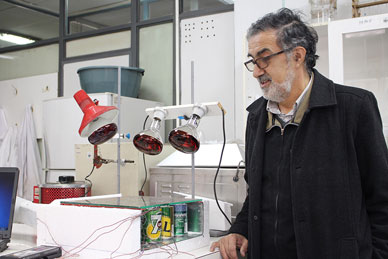- In order to reduce the effects of the day-night fluctuations of solar radiation, researchers at the Department of Chemical Engineering of Universidad de Santiago developed a low-cost accumulator that allows storing solar thermal energy and avoid interruptions of the drying processes of different agricultural products. The research team is led by Dr Alejandro Reyes and the study is called “Design and evaluation of a heat exchanger that uses paraffin wax and recycled materials as solar energy accumulator”.
Chile has high levels of solar radiation, particularly in the northern and central zones of the country. This makes our territory an ideal area for studying and developing new methods to use solar energy.
In this context, Dr Alejandro Reyes published part of the results of his study in the Elsevier’s journal Energy Conversion and Management. The article is called “Design and evaluation of a heat exchanger that uses paraffin wax and recycled materials as solar energy accumulator.”
Through this study, Professor Reyes seeks to solve one of the biggest problems posed by solar thermal energy: its fluctuation between day and night. He has the goal of extending the use of solar energy to hours when it is not directly received.
Solar energy can be thermally or electrically stored in batteries, by means of photovoltaic panels. In thermal storage, solids or liquids can be heated and sensible heat is stored. However, Dr Reyes’ study is focused on the phase change, i.e., the use of a solid that melts when it is heated.
Paraffin wax
Paraffin wax, similar to the one used in candle making, was the best option for this study, as it remains solid below 56OC and, above this temperature, it changes to liquid.
The change in state of paraffin wax depends on energy input or output. “For a phase transition from solid to liquid, much energy is required, so we get it from the sun. And from liquid to solid, we need to take the energy inside out,” Professor Reyes explained.
In order to melt wax and transform it to liquid and accumulate energy, Dr Reyes designed a heat accumulator that works with low-cost materials, like soft drink cans. “We designed a device in which we put paraffin in a group of soft drink cans that we painted black. We put the cans inside a box, and we closed the upper face with a glass cover, facing the sun. The solar energy melts the wax and then a cold air flow is passed trough the cans and goes out as hot air,” he said.
However, this process has some drawbacks related to the low thermal conductivity of paraffin wax that makes more difficult sucking out the heat from the cans: when liquid paraffin wax starts getting solid inside the cans, the extraction of the energy remaining in the centre of the cans is very slow.
This problem was solved by embedding aluminium wool in the paraffin wax, doubling its thermal conductivity. Aluminium strips were also placed outside the cans to improve the energy transfer to the air.
Mathematical equations
Professor Reyes says that the empirical results are correlated with the models that they have been able to develop through mathematical equations.
“Evidently, if we build a device with more cans, the energy accumulation would be proportionally higher. We have another piece of equipment with 300 cans placed on the roof of the Department of Chemical Engineering that allows extending the drying process of agroproducts to up to five hours. We have the help of thesis students and experts in modelling and a piece of software that allows predicting the results of the equipment, based on its size and the environmental conditions,” he said.
Dr Reyes expects to replicate the energy accumulator and use it for different purposes. “On the roof, we have an accumulator made of cans, plus a standard solar panel, both connected to a dryer with a drying capacity of 25 kg of agricultural products. Up to date, we have dehydrated mushrooms, onion flakes, and sweet peppers, among others.”
As the process of drying agricultural products is slow, during the day the dryer uses the solar energy obtained through the solar panel, and then at night, when the solar radiation is null, the air for drying is heated in the energy accumulator and the drying time is extended to up to 5 additional hours.
“We seek to extend the drying process all night long, by using solar energy, in spite of the radiation fluctuations between day and night,” the researcher said.
Translated by Marcela Contreras



